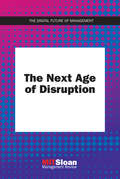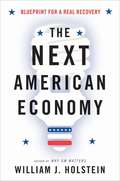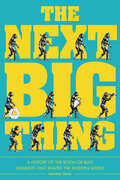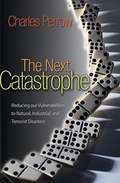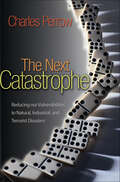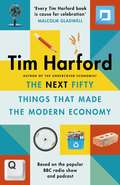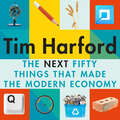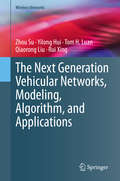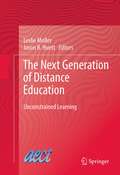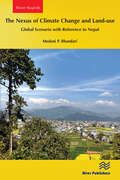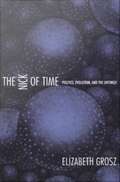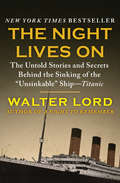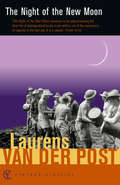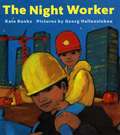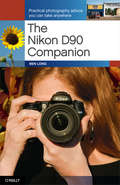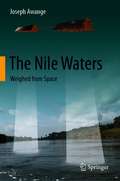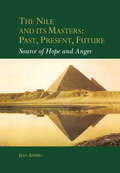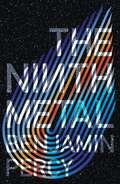- Table View
- List View
The Next Age of Disruption (The Digital Future of Management)
by MIT Sloan Management ReviewManagement experts discuss the innovation challenges that lie ahead, building on Clayton Christensen's famous theory of "disruptive innovation."Clayton Christensen's groundbreaking theory of "disruptive innovation" has proven to be one of the most influential management ideas of the last several decades. In this book, business and management experts--many of them Christensen's colleagues and former students--discuss the innovation challenges that lie ahead. Building on Christensen's work, they offer companies a guide for navigating a new world of disruption--a future in which artificial intelligence is a business tool, the speed of innovation increases dramatically, and capital is more easily accessible. The book also includes one of the last interviews with Christensen before his death in January 2020.
The Next American Economy: Blueprint for a Real Recovery
by William HolsteinAt a time when debate is raging about how to create jobs and revive the American economy, veteran business writer William J. Holstein argues that the best way for us to recover our economic footing is to do what Americans do best--innovate and create new industries. Contrary to the perception that the American economy has run out of inspiration and new ideas, Holstein uses compelling case studies to celebrate the innovation and business success being experienced in many industries, from technology and energy to retraining and exporting, across the country, from Boston to Orlando, Pittsburgh to San Diego. In the face of economic powerhouses such as Japan and China that are pursuing conscious national strategies, Holstein argues that Americans must find new avenues of cooperation among universities, business, and government to create the kind of sustainable growth we need. Replete with fresh insights into how Americans can create a real economic recovery,The Next American Economyis essential reading for business leaders, politicians, strategists, and anyone who cares about our future.
The Next Big Thing Is Really Small: How Nanotechnology Will Change the Future of Your Business
by Jack Uldrich Deb Newberrynanotechnology \na-no--tek-'nä-l -je-\ n (1987): the science of manipulating material at the atomic levelAlthough nanotechnology deals with the very small—a nanometer is 1/80,000th the diameter of a human hair—it is going to be huge. From the food we eat, the clothes we wear, and the products we manufacture to the composition of our bodies, everything is made of atoms. And if we can manipulate the atom, then that changes the rules of the game for almost every product.Coal and diamonds, for example, are both constructed from carbon atoms. It’s merely the arrangement of the atoms that differentiates an inexpensive fuel source from a pricey engagement jewel. While the science of nanotech cannot yet transform coal into diamonds, it is advancing rapidly and will begin to radically alter the business world during the next few years—and will continue to do so for the forseeable future. The buzz surrounding nanotech is comparable to that at the dawn of the digital revolution, which changed the face of how business operates. Unlike the Internet, however, which applied new technology to many old processes and businesses, nanotech is about creating entirely new materials, products, and systems (and therefore markets), as well as making existing products faster, stronger, and better.You may be tempted to wait until the buzz dies down before deciding how to integrate nanotech into your business, but don’t make the mistake of thinking of it as being light-years away. Even though it may sound far-off at times, within ten years nanotech will have huge effects on many industries, including manufacturing, health care, energy, agriculture, communications, transportation, and electronics. Within a decade, nanotechnology is expected to be the basis of $1 trillion worth of products in the United States alone and will create anywhere from 800,000 to 2 million new jobs. Nanotechnology will require you to radically re-think what your core business is, who your competitors are, what skills your workforce needs, how to train your employees, and how to think strategically about the future. Jack Uldrich and Deb Newberry explain exactly how you should prepare for nanotech’s imminent arrival. They identify today’s nanotech innovators, chronicle and project the rapid rise of nanotech developments, and show how to think strategically about the field’s opportunities and investments. The Next Big Thing Is Really Small provides a sneak peek at the technology that will transform the next ten years, giving investors and executives a road map for using small wonders to generate big profits.
The Next Big Thing: A History of the Boom-or-Bust Moments That Shaped the Modern World
by Richard FaulkWe are always hearing about the Next Big Thing. Whether it is a new iPhone or the New World, the freshest and newest inventions, discoveries, and fads loom large in the public mind. The impact that everyone thinks these "next big things" will have is often more important than the actual impact it generates. After all, if it fails, it will be almost immediately forgotten. The Next Big Thing searches through 3,000 years of Western culture to find the colorful and key steps (and missteps) that led us to where we are today. Paradigm-shifting events, such as the spread of ethical monotheism and the invention of the printing press stand beside such cultural ephemera as the aborted U.S metric campaign and the misbegotten vogue for smart drinks. Each entry features the historical context of that Next Big Thing as well as an overview of its legacy, including photos, sidebars, trivia, and quotes.
The Next Big Thing: A History of the Boom-or-Bust Moments That Shaped the Modern World
by Richard FaulkWe are always hearing about the Next Big Thing. Whether it is a new iPhone or the New World, the freshest and newest inventions, discoveries, and fads always loom large in the public mind. The impact that everyone thinks these "next big things" will have is often more important than the actual impact it generates. After all, if it fails, it will be almost immediately forgotten. The Next Big Thing searches through 3,000 years of Western culture to find the colorful and key steps (and missteps) that led us to where we are today.
The Next Catastrophe: Reducing Our Vulnerabilities to Natural, Industrial, and Terrorist Disasters
by Charles PerrowCharles Perrow is famous worldwide for his ideas about normal accidents, the notion that multiple and unexpected failures--catastrophes waiting to happen--are built into our society's complex systems. In The Next Catastrophe, he offers crucial insights into how to make us safer, proposing a bold new way of thinking about disaster preparedness. Perrow argues that rather than laying exclusive emphasis on protecting targets, we should reduce their size to minimize damage and diminish their attractiveness to terrorists. He focuses on three causes of disaster--natural, organizational, and deliberate--and shows that our best hope lies in the deconcentration of high-risk populations, corporate power, and critical infrastructures such as electric energy, computer systems, and the chemical and food industries. Perrow reveals how the threat of catastrophe is on the rise, whether from terrorism, natural disasters, or industrial accidents. Along the way, he gives us the first comprehensive history of FEMA and the Department of Homeland Security and examines why these agencies are so ill equipped to protect us. The Next Catastrophe is a penetrating reassessment of the very real dangers we face today and what we must do to confront them. Written in a highly accessible style by a renowned systems-behavior expert, this book is essential reading for the twenty-first century. The events of September 11 and Hurricane Katrina--and the devastating human toll they wrought--were only the beginning. When the next big disaster comes, will we be ready?
The Next Catastrophe: Reducing our Vulnerabilities to Natural, Industrial, and Terrorist Disasters
by Charles PerrowCharles Perrow is famous worldwide for his ideas about normal accidents, the notion that multiple and unexpected failures--catastrophes waiting to happen--are built into our society's complex systems. In The Next Catastrophe, he offers crucial insights into how to make us safer, proposing a bold new way of thinking about disaster preparedness. Perrow argues that rather than laying exclusive emphasis on protecting targets, we should reduce their size to minimize damage and diminish their attractiveness to terrorists. He focuses on three causes of disaster--natural, organizational, and deliberate--and shows that our best hope lies in the deconcentration of high-risk populations, corporate power, and critical infrastructures such as electric energy, computer systems, and the chemical and food industries. Perrow reveals how the threat of catastrophe is on the rise, whether from terrorism, natural disasters, or industrial accidents. Along the way, he gives us the first comprehensive history of FEMA and the Department of Homeland Security and examines why these agencies are so ill equipped to protect us.The Next Catastrophe is a penetrating reassessment of the very real dangers we face today and what we must do to confront them. Written in a highly accessible style by a renowned systems-behavior expert, this book is essential reading for the twenty-first century. The events of September 11 and Hurricane Katrina--and the devastating human toll they wrought--were only the beginning. When the next big disaster comes, will we be ready? In a new preface to the paperback edition, Perrow examines the recent (and ongoing) catastrophes of the financial crisis, the BP oil spill, and global warming.
The Next Era in Hardware Security: A Perspective on Emerging Technologies for Secure Electronics
by Ozgur Sinanoglu Nikhil Rangarajan Satwik Patnaik Johann Knechtel Shaloo RakhejaThis book provides a comprehensive coverage of hardware security concepts, derived from the unique characteristics of emerging logic and memory devices and related architectures. The primary focus is on mapping device-specific properties, such as multi-functionality, runtime polymorphism, intrinsic entropy, nonlinearity, ease of heterogeneous integration, and tamper-resilience to the corresponding security primitives that they help realize, such as static and dynamic camouflaging, true random number generation, physically unclonable functions, secure heterogeneous and large-scale systems, and tamper-proof memories. The authors discuss several device technologies offering the desired properties (including spintronics switches, memristors, silicon nanowire transistors and ferroelectric devices) for such security primitives and schemes, while also providing a detailed case study for each of the outlined security applications. Overall, the book gives a holistic perspective of how the promising properties found in emerging devices, which are not readily afforded by traditional CMOS devices and systems, can help advance the field of hardware security.
The Next Fifty Things that Made the Modern Economy
by Tim Harford'Endlessly insightful and full of surprises - exactly what you would expect from Tim Harford' BILL BRYSON'Entertaining . . . A lively introduction to some of the most ingenious, yet often overlooked inventions that have changed the way we live' The Times'Every Tim Harford book is cause for celebration' MALCOLM GLADWELL'Harford is a fine, perceptive writer, and an effortless explainer of tricky concepts. His book teems with good things, and will expand the mind of anyone lucky enough to read it' Daily MailIn Fifty Things that Made the Modern Economy, the revolutionary, acclaimed book, radio series and podcast, bestselling economist Tim Harford introduced us to a selection of fifty radical inventions that changed the world.Now, in this new book, Harford once again brings us an array of remarkable, memorable, curious and often unexpected 'things' - inventions that teach us lessons by turns intimate and sweeping about the complex world economy we live in today.From the brick, blockchain and the bicycle to fire, the factory and fundraising, and from solar PV and the pencil to the postage stamp, this brilliant and enlightening collection resonates, fascinates and stimulates. It is a wonderful blend of insight and inspiration from one of Britain's finest non-fiction storytellers.
The Next Fifty Things that Made the Modern Economy
by Tim Harford'Endlessly insightful and full of surprises - exactly what you would expect from Tim Harford' BILL BRYSON'Entertaining . . . A lively introduction to some of the most ingenious, yet often overlooked inventions that have changed the way we live' The Times'Every Tim Harford book is cause for celebration' MALCOLM GLADWELL'Harford is a fine, perceptive writer, and an effortless explainer of tricky concepts. His book teems with good things, and will expand the mind of anyone lucky enough to read it' Daily MailIn Fifty Things that Made the Modern Economy, the revolutionary, acclaimed book, radio series and podcast, bestselling economist Tim Harford introduced us to a selection of fifty radical inventions that changed the world.Now, in this new book, Harford once again brings us an array of remarkable, memorable, curious and often unexpected 'things' - inventions that teach us lessons by turns intimate and sweeping about the complex world economy we live in today.From the brick, blockchain and the bicycle to fire, the factory and fundraising, and from solar PV and the pencil to the postage stamp, this brilliant and enlightening collection resonates, fascinates and stimulates. It is a wonderful blend of insight and inspiration from one of Britain's finest non-fiction storytellers.
The Next Generation Vehicular Networks, Modeling, Algorithm and Applications (Wireless Networks)
by Tom H. Luan Zhou Su Yilong Hui Qiaorong Liu Rui XingThis book proposes the novel network envisions and framework design principles, in order to systematically expound the next generation vehicular networks, including the modelling, algorithms and practical applications. It focuses on the key enabling technologies to design the next generation vehicular networks with various vehicular services to realize the safe, convenient and comfortable driving. The next generation vehicular networks has emerged to provide services with a high quality of experience (QoE) to vehicles, where both better network maintainability and sustainability can be obtained than before.The framework design principles and related network architecture are also covered in this book. Then, the series of research topics are discussed including the reputation based content centric delivery, the contract based mobile edge caching, the Stackelberg game model based computation offloading, the auction game based secure computation offloading, the bargain game based security protection and the deep learning based autonomous driving. Finally, the investigation, development and future works are also introduced for designing the next generation vehicular networks.The primary audience for this book are researchers, who work in computer science and electronic engineering. Professionals working in the field of mobile networks and communications, as well as engineers and technical staff who work on the development or the standard of computer networks will also find this book useful as a reference.
The Next Generation of Distance Education
by Jason B. Huett Leslie MollerThe world of education is being radically altered with the change being driven by technology, openness, and unprecedented access to knowledge. Older correspondence-style methods of instructional delivery are passé and "classroom adapted to the web" approaches to learning are often ineffective and do little to harness the transformational potential of technology. E-Learning scenarios, mobile technologies, communication and information access, and personal learning environments are becoming mainstream and, as a result, control of the learning process is shifting away from institutions and into the hands of learners. This volumes promotes a forward-thinking agenda for research and scholarship that highlights new ideas, deep insights, and novel approaches to "unconstrained" learning.
The Next Green Revolution: Essential Steps to a Healthy, Sustainable Agriculture
by Jim Horne Raymond P Poincelot Maura McdermottExplore the benefits of and necessity for sustainable agriculture!Here is an easy-to-read, practical introduction to sustainable agriculture: what it means and why it is needed. It is the first book to synthesize the goals of sustainable agriculture into eight comprehensive steps. The Next Green Revolution presents a convincing critique of our current agricultural system and an introduction to an alternative system which gives more consideration to future generations. Interwoven through the book are Dr. Horne's reflections on social justice, quality of life, and how farmers and rural communities are inextricably linked.The Next Green Revolution draws on the unique perspective of Dr. James E. Horne, President of a leading nonprofit agriculture organization, the Kerr Center for Sustainable Agriculture. It is inspired by his experience as a traditional agriculturalist and educator coming to grips with the failings of the conventional system and searching for an alternative. Writing in the first person, he describes growing up in a sharecropper family in Oklahoma, running his own ranch, and consulting with farmers as an agricultural economist. He shares what he learned as the Kerr Center experimented with new “sustainable” approaches to old problems on the Center's ranch/farm, and his experiences working with the USDA's Sustainable Agriculture Research and Education Program. With The Next Green Revolution, you will explore: the major problems of contemporary industrial agriculture definitions of sustainable agriculture the historical roots of sustainable agriculture the politics of sustainable agriculture sustainable agriculture practices changes needed to encourage a sustainable agriculture and the eight steps to sustainable agriculture, which address: soil health and erosion water quality and use organic waste management crop and livestock adaptation biodiversity environmentally benign pest management energy use farm diversification profitability The Next Green Revolution is a well-researched introduction to the field, written with a minimum of jargon.
The Next One Hundred Years: Shaping the Fate of Our Living Earth
by Jonathan WeinerA detailed but non-technical analysis of the state of the planet today and during the next century by the author of Planet Earth.
The Next Wave: The Quest to Harness the Power of the Oceans (Scientists in the Field Series)
by Elizabeth RuschJourney to the wave-battered coast of the Pacific Northwest to meet some of the engineers and scientists working to harness the punishing force of our oceans, one of the nature’s powerful and renewable energy sources. With an array of amazing devices that cling to the bottom of the sea floor and surf on the crests of waves, these explorers are using a combination of science, imagination, and innovation to try to capture wave energy in the hopes of someday powering our lives in a cleaner, more sustainable way.
The Nexus of Climate Change and Land-use – Global Scenario with Reference to Nepal
by Medani P. BhandariThe interplay between land use and climate change is a crucial aspect of sustainable development, especially in Nepal. This book delves into the intricate connections between land-use and climate change in Nepal, shedding light on significant challenges and potential opportunities. Nepal, with its diverse topography and ecosystems, is exceptionally susceptible to the impacts of climate change. The distinctive land-use patterns, encompassing agriculture, forest cover, and urbanization, significantly influence the country's climate resilience and carbon balance. However, rapid population growth, urban expansion, and changing land-use practices have led to environmental degradation and a surge in greenhouse gas emissions. The alarming deforestation, driven by agricultural expansion, infrastructure development, and unsustainable logging, has contributed to carbon emissions and the depletion of vital ecosystem services. Consequently, the conversion of forested land into agricultural fields has negatively affected biodiversity, soil erosion, and water resources, intensifying the vulnerability of communities to climate change. Nevertheless, embracing sustainable land-use practices like afforestation, reforestation, and agroforestry holds promise for mitigating the impacts of climate change and enhancing resilience. The promotion of climate-smart agriculture, watershed management, and community-based forestry can aid in conserving ecosystems, sequestering carbon, and improving livelihoods. This study illustrates the intricate relationship between land-use and climate change, emphasizing the importance of striking a balance in land-use practices, conserving forests, and biodiversity, and promoting sustainable agriculture. These efforts are indispensable for achieving climate resilience and sustainable development in Nepal. By addressing the nexus between land-use and climate change, Nepal can pave the way towards a more sustainable and climate-resilient future. The purpose of this book is to present the core concepts of this issue, inspire further research, and propose solutions to mitigate the problems caused by human disturbances in the Earth's ecosystem.
The Nick of Time: Politics, Evolution, and the Untimely
by Elizabeth GroszIn this pathbreaking philosophical work, Elizabeth Grosz points the way toward a theory of becoming to replace the prevailing ontologies of being in social, political, and biological discourse. Arguing that theories of temporality have significant and underappreciated relevance to the social dimensions of science and the political dimensions of struggle, Grosz engages key theoretical concerns related to the reality of time. She explores the effect of time on the organization of matter and on the emergence and development of biological life. Considering how the relentless forward movement of time might be conceived in political and social terms, she begins to formulate a model of time that incorporates the future and its capacity to supersede and transform the past and present. Grosz develops her argument by juxtaposing the work of three major figures in Western thought: Charles Darwin, Friedrich Nietzsche, and Henri Bergson. She reveals that in theorizing time as an active, positive phenomenon with its own characteristics and specific effects, each of these thinkers had a profound effect on contemporary understandings of the body in relation to time. She shows how their allied concepts of life, evolution, and becoming are manifest in the work of Gilles Deleuze and Luce Irigaray. Throughout The Nick of Time, Grosz emphasizes the political and cultural imperative to fundamentally rethink time: the more clearly we understand our temporal location as beings straddling the past and the future without the security of a stable and abiding present, the more transformation becomes conceivable.
The Night Before: ‘A dazzling hall-of-mirrors thriller' AJ Finn
by Wendy Walker'Ferociously smart.' AJ Finn'Another page-turning cracker' BA ParisFIRST DATES CAN BE MURDER...Laura has never been lucky in love. She falls too hard and too fast, always choosing the wrong men. Devastated by the end of her last relationship, she fled her apartment for her sister's home in the suburb where they both grew up. Though still haunted by the tragedy that's defined her entire life, Laura is determined to take one more chance on love with a man she's met on an Internet dating site.Rosie has spent most of her life worrying about her troubled sister. Laura's return, under mysterious circumstances, has cast a shadow over Rosie's peaceful life with her husband and young son - a shadow that grows darker as Laura leaves the house for her blind date.When Laura doesn't return home the following morning, Rosie fears the worst. She's not responding to calls or texts, and she's left no information about the man she planned to meet. As Rosie begins a desperate search to find her sister, she is not just worried about what this man might have done to Laura. She's worried about what Laura may have done to him...'Riveting.' Riley Sager 'Addictive.' Liv Constantine 'Wonderfully tense.' Aimee Molloy 'Irresistible.' Mary Kubica 'Impossible to put down.' Megan Miranda
The Night Lives On: The Untold Stories and Secrets Behind the Sinking of the "Unsinkable" Ship—Titanic (The Titanic Chronicles #2)
by Walter LordIn this New York Times bestseller, the author of A Night to Remember and The Miracle of Dunkirk revisits the Titanic disaster. Walter Lord&’s A Night to Remember was a landmark work that recounted the harrowing events of April 14, 1912, when the British ocean liner RMS Titanic went down in the North Atlantic Ocean, a book that inspired a classic movie of the same name. In The Night Lives On, Lord takes the exploration further, revealing information about the ship&’s last hours that emerged in the decades that followed, and separating myths from facts. Was the ship really christened before setting sail on its maiden voyage? What song did the band play as water spilled over the bow? How did the ship&’s wireless operators fail so badly, and why did the nearby Californian, just ten miles away when the Titanic struck the iceberg, not come to the rescue? Lord answers these questions and more, in a gripping investigation of the night when approximately 1,500 victims were lost to the sea.
The Night Of The New Moon
by Sir Laurens Van Der PostThis book is the remarkable story of his experiences in the prison camp, but it is also a meditation on the morality of the Bomb, a compassionate and moving contemplation of human violence.
The Night Worker
by Kate Banks Georg HallenslebenOne night, Alex's father surprises his son by taking him to see his place of work, an exciting construction site with heavy machinery, rumbling sounds, and more.
The Nikon D90 Companion: Practical Photography Advice You Can Take Anywhere
by Ben LongThrough easy-to-follow lessons, this handy book offers a complete class on digital photography, tailored specifically for people who use the Nikon D90. This is not your typical camera guide: rather than just show you what all the buttons do, it teaches you how to use the D90's features to make great photographs-including professional-looking images of people, landscapes, action shots, close-ups, night shots, HD video, and more. With Ben Long's creative tips and technical advice, you have the perfect, camera-bag-friendly reference that will help you capture stunning pictures anywhere, anytime. The Nikon D90 Companion will show you how to: Take creative control and go beyond automatic settings Learn the basic rules of composition Capture decisive moments, including fast-moving objects Discover ways to use a flash indoors and outdoors Learn about different lenses, and the best time to use them Understand the options for shooting RAW, and whether it's right for you Use the D90's ability to shoot high definition video
The Nile Waters: Weighed from Space
by Joseph AwangeThis book is useful to those in water resources management and policy formulations, hydrologists, environmentalists, engineers and researchers. Exploiting advanced statistical techniques and the latest state-of-the-art multi-mission satellites, surface models and reanalysis products, this book provides the first comprehensive weighing of the changes in the Nile River Basin’s (NRB: ~ 3,400,000 km2 ) stored waters' compartments, surface, soil moisture and groundwater, and their association to climate variability/change and anthropogenic impacts on the one hand. On the other hand, it argues on the need for equitable use of the NRB’s waters by all 11 countries within its basin, and doing away with obsolete Nile treaties that were signed by Britain, Egypt and Sudan, which prohibit the use of the Nile by 8 upstream countries. With Ethiopia’s construction of Africa’s largest dam (GERD; Grand Ethiopian Renaissance Dam) along the Blue Nile, which is expected to take several years to fill, the Nile is back on the news. Combined with Uganda’s Nalubaale, Kiira and Bujagali dams on the White Nile, these human-induced impacts (i.e., damming), coupled with those of climate variability/change, are expected to exacerbate tension with the low stream countries (Egypt and Sudan) fearing the cut in theNile’s total volume. Furthermore, the Nile river, arguably the world’s longest river (6800 km), impacts on the livelihood of over 300 million people of 11 countries within its basin. This population is expected to double in the next twenty-five years, thereby putting extreme pressure on its water resources. An in-depth analysis of changes in the Nile’s stored waters, therefore, is essential to inform its management and sustainable equitable use. Owing to its sheer size, however, obtaining in-situ data from “boots on the ground” is practically impossible, paving way to the space-based weighing of the Nile River Basin using a suite of high spatio-temporal remotely sensed and reanalysis products, as well as those of hydrological models. “Arguably, the Nile River is the most unique river in the world. It spans extremes of rainfall from being measured by meters to being measured by centimeters, from the humid tropics to the driest of deserts. Yet, thirsty people live throughout this basin and therefore the demands on its water resources are uneven. Knowing the water amounts throughout the entire Nile Basin is a critical step for governments and international treaties to avoid the “Tragedy of the Commons”. Africa can embrace this future through the leadership of Prof. Awange and others like him who have devoted their careers to Africa’s waters” —Doug Alsdorf, Ph.D., Professor of Geophysics at the Ohio State University (USA).
The Nile and Its Masters: Source of Hope and Anger
by Jean KeriselThe Pharoahs were masters of the Nile: they had a detailed understanding of the ways of the river. Modern Egyptians see themselves as heirs to this tradition, and as owners of the Nile waters. In the 1960's, Egypt decided to protect its increasingly-populated Nile valley from the ravages of annual flooding by building a dam. A relatively small dam in the valley of Nubia, in the region of Tushka, would have enabled the excess floodwaters to safely be diverted towards the fossil valley of the pre-Nile. However, it was decided to select a site near Aswan, making it necessary to inundate more than 250km of river valley. Over the years, this strategy has been revealed to have been faulty, and numerous irrigation schemes in upriver countries have progressively reduced the amount of water descending into Egypt. The dire warning of the 14th century oracle appears to be prophetic: "the water of the river in my country will be stopped from reaching yours, which I shall cause to die of thirst..."
The Ninth Metal: The Comet Cycle Book 1 (The Comet Cycle #1)
by Benjamin Percy'Great characters, fine writing, totally engrossing' STEPHEN KING It might have been the end of days. Instead it was the beginning of something shockingly new. They called the comet Cain, after the astronomer who discovered it. It passed 500,000 miles from Earth. We were spared planetary destruction and granted a light show like no other. But, one year later, Earth span into the debris field left by the comet and a meteor storm struck. Roads, buildings and even a small town were annihilated.The meteors impacted heavily around the dying mining town of Northfall, Minnesota. It was the night of a mysterious double murder, the deed overshadowed by the discovery that the burning remains of the rock contained an unknown substance more precious than gold: the Ninth Metal. And with that discovery, everything changed.Benjamin Percy is an award-winning novelist, celebrated comic books writer and author of the Wolverine podcast. The Ninth Metal is the first of a cycle of novels set in a shared universe.Praise for The Ninth Metal:'Whether you choose to think of him as the Elmore Leonard of rural Minnesota or the Stephen King of Science Fiction, Percy - with his extraordinary and unrelenting eye - dishes up humanity like some kind of otherworldly blue plate special, at once deeply familiar and wildly new' Margaret Stohl, No. 1 New York Times Bestselling Author'Take one part dystopia, one part sci-fi, two parts apocalypse, then ride them roughshod through a bleak and bloody western, and it still wouldn't get close to what Ben Percy does here, which is blow open the core of humanity's dark heart' Marlon James, Booker Prize winning author of Black Leopard, Red Wolf'The Ninth Metal continues his streak of thrilling, incisive genre bending goodness. It's a sci-fi novel, a crime novel and a super-hero novel, too. Audacious and intelligent and exactly what I was dying to read' Victor LaValle, author of The Changeling
